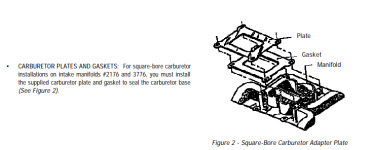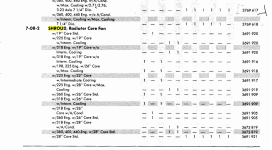Pretty sure the gaskets I was using many years ago didn't have adhesive on them so the roll pin holds them in place until you can get it snugged down and the RTV sets up.
It doesn't seem like it'd be a very effective solution. It's only going to hold the center of the gasket. The ends of it are out near the bolts and free to push out wherever they please. My W2 gaskets came with attempted mitigation in that area--small fingers that are supposed to hold it--but again, those fingers no place good to go as the bolts are tightened so I snipped 'em off. Black silicone works a treat and allows the intake to come off easily if used correctly.
Looked again and don't have print o seal gaskets, just plain old composite and 3 steel ones. Haven't used the spray tack for over a year should probably buy a fresh can.
It's probably fine unless the nozzle's clogged. Air can't get into the can, so if the ball still rattles, shake 'er up and spray a little on a test piece of cardboard to check. I haven't checked it recently, but one can I have is over a decade old and I'm pretty sure it's still good to go. I bought it long before I left the Iron Mountain store in 2011 and successfully used it on Agnes' engine in June of '19. Without exposure to moisture or air, i.e. inside the can, there's little that can really go wrong. Hell, in several of those intervening years I had no garage heat, so if it even
can freeze it certainly did.
I need a better shroud though. It's pure junk.
Originals are actually quite good if you can find one. I'm not certain as to the interchangeability of fan shrouds between the various years, though. The parts book doesn't show a 26" shroud for A-bodies until 1973, and in that year the 22" shroud numbers changed from the '70-'71 part numbers. Does your car have an original radiator with a number on it, or a Chinesium wannabe like Agnes?
The problem is that A-bodies with maximum cooling were not the majority; you need one from a 340/360 or a V8/AC application. A-body buyers were inherently looking to save money so while lots of HP Darts and Dusters were built, they pale in the overall numbers. AC wasn't terribly popular either, especially up this way. Shrouds can be tough to find.
The only shroud that was in our "local" yard was on a loaded '75 Valiant Brougham (heavy on the
Bro, yo) that got shredded. That was a 26", but they don't show that size shroud prior to '73. Both of my Valiants are (now) 22" radiators, neither with a shroud, but both left the factory with the wee 19" radiator owing to their non-AC Slant Six configurations. Truth be known, you're ahead of the game even with the crappy one, but I had no overheating issues with Agnes with the 22" aluminum Asian unit and a clutched 5-blade "cop" fan even with ambient temps near 100°... and you've got the advantage of aluminum heads, so I don't expect you'll have any trouble.


